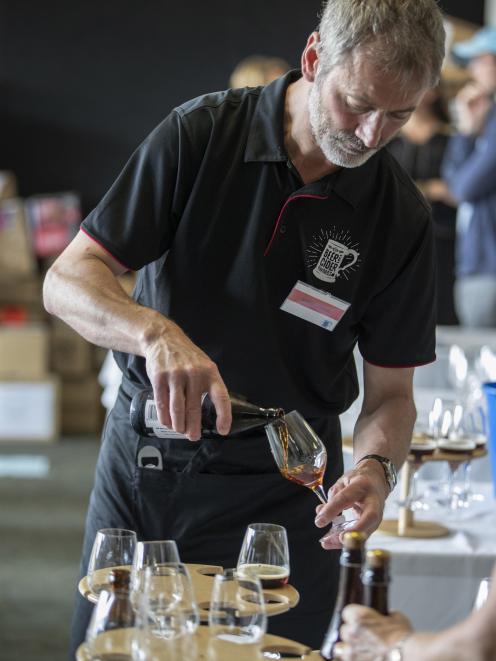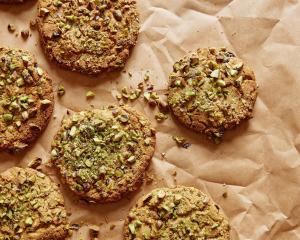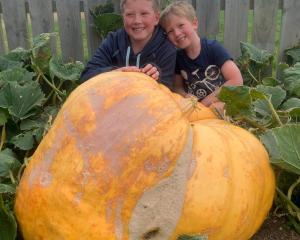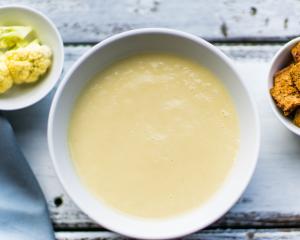
Rebecca Fox talks to the judges to find out what it takes to get a gold sticker on your bottle.
As pens hit glasses, a tinkling rings out.
The group sitting around a round table grins at each other in satisfaction — they have discovered a great brew.
It is a tradition in judging beers or cider at the New World Beer and Cider Awards when the group of four to six judges agrees the beer or cider falls into the ‘‘if this is my last beer I’d die happy’’ category — ones that score 85-100%.

They work in teams blind tasting around 40 to 50 beers or ciders in a day, during two days of judging.
Behind a black wall, a team of stewards carefully sorts and tags the beers, pours them into wine glasses — the long stem means no fingerprints on the bowl so judges can accurately assess colour and the shape of the bowl allows them to judge the aroma — and makes sure they are served at the brewer’s recommended temperature for each beer.
The stewarding team places four beers — identified only by a small white label with a number on it — in front of each judge. Each judge then tastes each beer simultaneously rating each one on colour, aroma, technical excellence, balance, mouthfeel and drinkability.
It is a well-oiled process, says head judge beer writer and author Michael Donaldson.
And one judges enjoy because it enables them to test a beer with a focus on the consumer rather than the technical excellence other industry awards are seeking.
‘‘We ask if a beer is well made, are people going to enjoy drinking this? It is a subtle difference.’’
The goal is to find the top 30 most drinkable beers or ciders.
It is not always an easy process. Most of the time, the judging group has different opinions about a beer — one can like it, another not.

‘‘It’s quite challenging and complex ... but collegial. What delights one person doesn’t another; everyone has different palates.’’
At all times they are keeping in mind what the average drinker would enjoy, rating the beers on a scale ranging from the ‘‘die happy’’ 100% to ‘‘great beer I’d go home satisfied’’ (78%-84%) to ‘‘good enough’’ to try again (70-77%).
‘‘They’re asking themselves it is not quite right but would I get another? What is it about this beer that would make someone buy it.
‘‘They’ve got to focus not just on its faults but its flavour.’’
The judges themselves have been selected for the job, not only for their technical skill but for having a good palate and the ability to articulate the flavours and aromas they are tasting in non-technical terms.
‘‘All have a lot of experience in the industry. The best judges have a great imagination and sensory ability.’’
Pratt, who has been judging for six years, says judging provides a rare opportunity for brewers to get to taste the range of beers on the market.
‘‘We’re blind tasting up to 50 beers a day.’’
It is also a great chance to catch up with other brewers and collaborate with others in the industry.
‘‘It’s good to see the quality in the industry in the most part going up. It’s in a good space at the moment.’’

‘‘It was a good one, we all agreed.’’
Donaldson said standing in front of beer stands at a supermarket or liquor outlets can be confusing for beer drinkers, as there are so many options today, mainly due to the explosion in the craft beer market.
‘‘I’m a bit like that myself when I want to try something new.’’
Donaldson believes those sellers could do a lot more to help consumers by stocking their shelves based on beer styles rather than by brewer — as wine is.
He hopes to help consumers by writing up descriptions and key words to go alongside the top 30 beers to give people an idea of what they could buy.
‘‘It’s not easy to do with 30 beers, but it’s fun.’’
New Zealand’s beer market had been very uniform for a long time but in the past decade more and more different beers have been produced.
These days you can find cucumber-flavoured beers or those flavoured with watermelon, lychees, grapefruit or a combination of.
‘‘These beers might not taste like what our grandparents or fathers thought was beer.’’
However, those beers are thought of as normal in Belgium.
‘‘That’s what beer taste’s like. So in some way we are catching up with the rest of the world — we’re reinventing traditional styles.’’
Emerson’s was one of the first to go there, showing people there was more to beer than they traditionally thought.
‘‘We need people like that who push the boundaries.’’
It also sat alongside a change in the drinking culture from one where beer was to be guzzled in the shortest space of time possible to one where it was enjoyed and savoured.
‘‘You have to slow down to appreciate them and I think the drinking culture will go for it now. It’s so far removed from the six o'clock swill.’’
Drinkers were now looking for quality, point of difference, flavour and experience.
The Top 30 beers will be announced later this year.
-Rebecca Fox was hosted by Foodstuffs.
AT A GLANCE
- 600 beers entered from more than 100 breweries and cider makers
- 13 pallets of beer, cider, glasses and other equipment needed
- 16 stewards needed to set up more than 5100 bottles
- Stewards will pour more than 3000 glasses of beer and cider over two days
- Dedicated glass washers will keep 1,600 Spiegelau glasses clean
TOP TRENDS FOR 2020
New World Beer and Cider Awards head judge Michael Donaldson’s three top trends for 2020. —
The haze craze — hazy IPAs
For centuries beer has been filtered to provide a clear, sparkling drink, but in the past few years, stemming from a movement which began in Vermont, organic beer that is unpasteurised and unfiltered is becoming popular. The solid material in the beer from the fermentation process stays in the beer so you cannot see through it.
The beers can be described as ‘‘juice bombs’’ as they taste ‘‘juicy’’ with tropical fruit characters and accents that play down bitterness.
Fruited sours
These are beers such as raspberry sours or passionate fruit sours that ‘‘do not taste like beer’’. They are new to the market and are aimed at people who do not like beer.
The beer is deliberately soured in the traditional European ways, and fruit flavours added. Some are soured in barrels, others afterwards using a similar bacteria to that found in yoghurt. They have lower acidity and make a great refreshing summer drink.
Lager is back
Or has it ever gone away? Lager has always been the purview of the big breweries and the craft brewers stayed away from it, but that is starting to change. Lagers need to be well-balanced and have a narrow flavour profile to be a crisp, refreshing style. Brewers also needed to take the time to do it properly as it requires storing for at least six weeks to smooth out the flavours.











